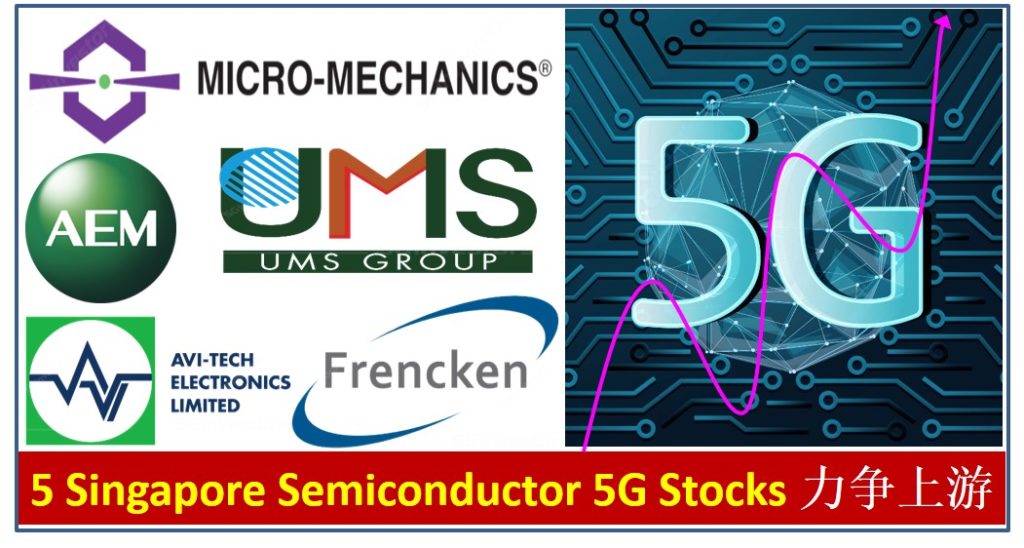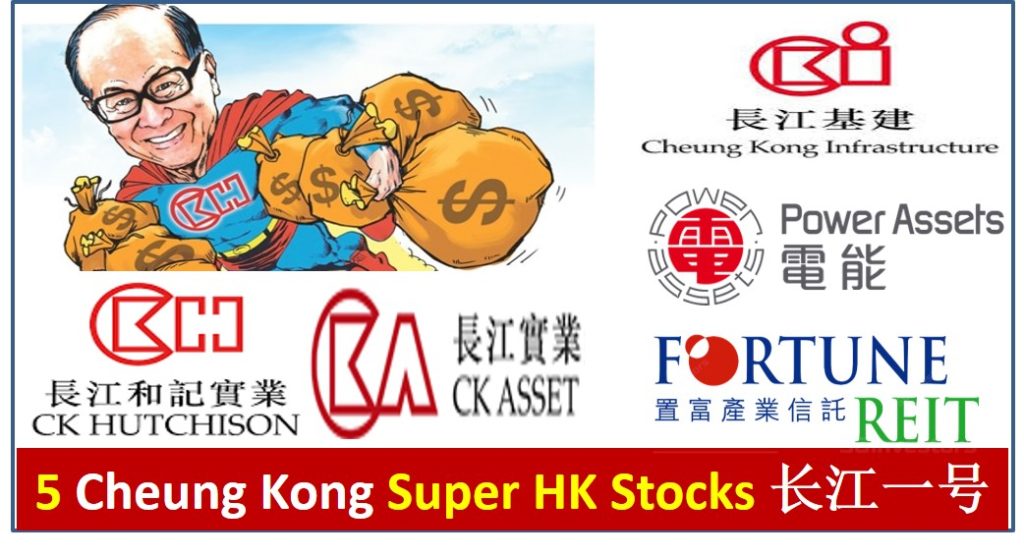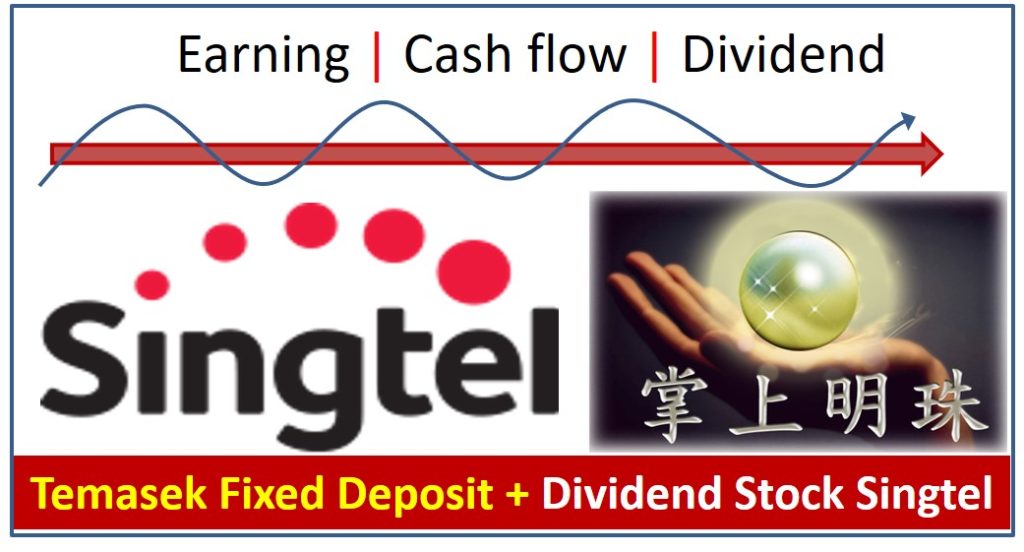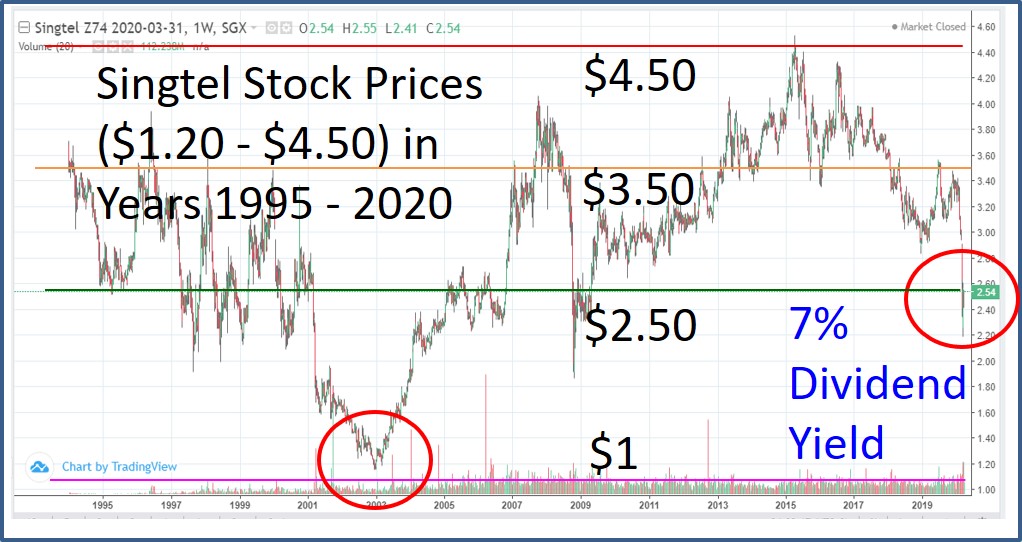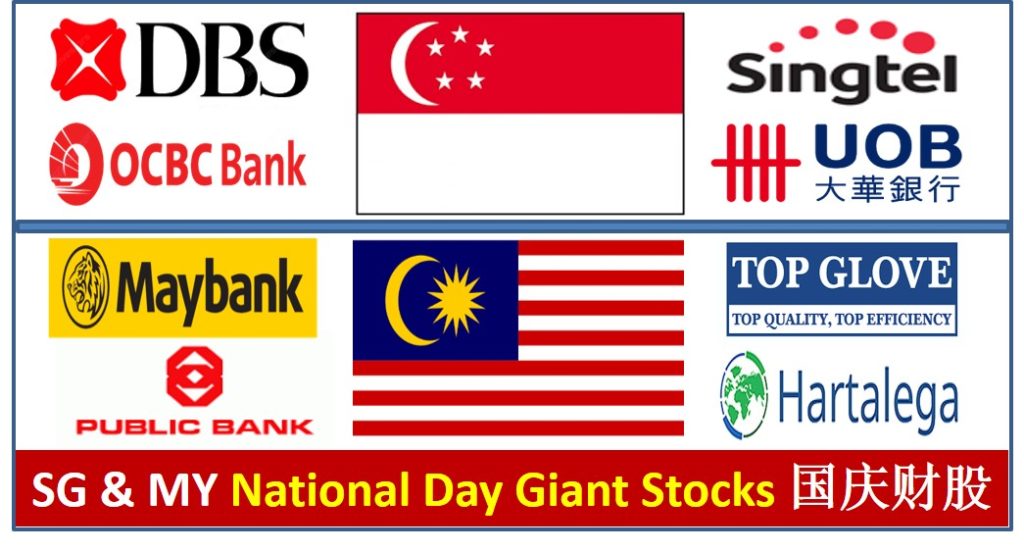
Both Singapore and Malaysia celebrate National Day in the month of August. It is timely to share the 4 National Giant Stocks in each country which preserve the national wealth. Learn from Dr Tee on how to position these stocks during COVID-19 stock crisis.
4 Singapore National Stocks:
1) DBS (SGX: D05)
2) Singtel (SGX: Z74)
3) OCBC (SGX: O39)
4) UOB (SGX: U11)
4 Malaysia National Stocks:
1) Maybank (Bursa: 1155)
2) Top Glove (Bursa: 7113) / (SGX: BVA)
3) Hartalega (Bursa: 5168)
4) Public Bank (Bursa: 1295)
Stock market is a hidden way to preserve and grow the national wealth. For Singapore SGX, there are 30 large cap stocks in STI Index (^STI), which can be sorted below by size of market cap (share price x number of shares) with ROE (Return on Equity):
No Name / Market Cap(M) (ROE, %)
1 DBS Bank (SGX: D05) 52304 (12.3)
2 Singtel (SGX: Z74) 38761 (4.0)
3 OCBC Bank (SGX: O39) 38413 (10.3)
4 UOB Bank (SGX: U11) 32687 (11.0)
5 Wilmar International (SGX: F34) 30509 (7.7)
6 Jardine Matheson Holdings JMH (SGX: J36) 29865 (9.4)
7 Jardine Strategic Holdings JSH (SGX: J37) 22731 ( 6.1)
8 Thai Beverage (SGX: Y92) 15195 (20.1)
9 CapitaLand (SGX: C31) 13844 (8.8)
10 Ascendas Reit (SGX: A17U) 12489 (4.8)
11 Singapore Airlines (SGX: C6L) 10346 (-0.1)
12 ST Engineering (SGX: S63) 10042 (26.0)
13 Keppel Corp (SGX: BN4) 9830 (6.3)
14 Singapore Exchange (SGX: S68) 9236 (37.9)
15 Hongkong Land USD (SGX: H78) 8635 (0.5)
16 Genting Singapore (SGX: G13) 8204 (8.5)
17 Mapletree Logistics Trust (SGX: M44U) 8027 (8.2)
18 Jardine Cycle & Carriage (SGX: C07) 7659 (12.8)
19 Mapletree Industrial Trust (SGX: ME8U) 7490 (10.3)
20 City Development (SGX: C09) 7463 (5.2)
21 CapitaLand Mall Trust (SGX: C38U) 6937 (9.0)
22 CapitaLand Commercial Trust (SGX: C61U) 6294 (6.0)
23 Mapletree Commercial Trust (SGX: N2IU) 6130 (9.4)
24 Dairy Farm International (SGX: D01) 5897 (26.8)
25 UOL (SGX: U14) 5491 (4.8)
26 Venture Corporation (SGX: V03) 5449 (14.5)
27 YZJ Shipbldg SGD (SGX: BS6) 3801 (10.0)
28 Sembcorp Industries (SGX: U96) 3394 (3.1)
29 SATS (SGX: S58) 3017 (10.4)
30 ComfortDelGro (SGX: C52) 2990 (10.2)
It is clear that the Top 4 stocks with the largest market cap in Singapore are DBS (SGX: D05), Singtel (SGX: Z74), OCBC (SGX: O39) and UOB (SGX: U11). Company size may not be the right criteria of a giant stock, therefore an investor has to monitor business fundamental changes (especially during COVID-19 pandemic), eg with ROE and other indicators.
For 30 STI stocks, only Singapore Airlines, SIA (SGX: C6L) records losses in last financial year. For 30 STI stocks, COVID-19 has different degrees of impact on near future business. There is also on-going crisis, eg. low optimism crude oil price which affects the Oil & Gas sector, including Keppel Corp (SGX: BN4) and Sembcorp Industries (SGX: U96), which may take longer time to recover with strong support of sponsor, Temasek.
3 major bank stocks (DBS, OCBC, UOB) in Singapore have contributed to about 1/3 of Singapore stock market. Bank stocks are sensitive to interest rate changes, therefore current low interest rates globally (driven by nearly 0% interest rate by the Fed of US) have reduced the Net Interest Margin (NIM), resulting in lower interest related income. At the same time, Non-Performing Loan (NPL) is increasing during COVID-19, banks have to increase more provision funds to prepare for possible default in loan payment of some countries, including Oil & Gas sector (eg. Hin Leong which has high debt to 3 major banks). As a result, it is not surprised to see bank stocks report poorer quarterly results for Q1 and Q2 / 2020.
MAS has requested 3 major banks in Singapore to cap the dividend payment for FY2020 to maximum of 60% of FY2019. This implies for an average dividend yield of 6%, an investor may only receive 6 x 0.6 = 3.6% for the next 1 year. As a result, 3 major bank stocks were under significant price correction recently (which also affect performance of STI). However, a long term bank stock investor should not consider dividend payment as a criteria to decide on investing. In fact, the share price correction of over 3% in 1 week has compensated for the “loss” of dividend (which is kept as retained earnings in balance sheet, a form of saving for investor, similar to many REITs in Q1 and Q2 / 2020 to preserve cash).
Here is a list of 30 Banking & Finance stocks in Singapore, an investor may focus on 3 major bank stocks:
AMTD IB OV (SGX: HKB), B&M Hldg (SGX: CJN), DBS Bank (SGX: D05), Edition (SGX: 5HG), G K Goh (SGX: G41), Global Investment (SGX: B73), Great Eastern (SGX: G07), Hong Leong Finance (SGX: S41), Hotung Investment (SGX: BLS), IFAST Corporation (SGX: AIY), IFS Capital (SGX: I49), Intraco (SGX: I06), Maxi-Cash Finance (SGX: 5UF), MoneyMax Finance (SGX: 5WJ), Net Pacific Finance (SGX: 5QY), OCBC Bank (SGX: O39), Pacific Century (SGX: P15), Prudential USD (SGX: K6S), Singapore Exchange (SGX: S68), SHS (SGX: 566), Sing Investments & Finance (SGX: S35), Singapore Reinsurance (SGX: S49), Singapura Finance (SGX: S23), TIH (SGX: T55), Uni-Asia Group (SGX: CHJ), UOB Bank (SGX: U11), UOB-KAY HIAN HOLDINGS (SGX: U10), UOI (SGX: U13), ValueMax (SGX: T6I), Vibrant Group (SGX: BIP).
Singtel is also a crisis giant stock in bearish Telco sector (started a few years before COVID-19), an investor who “Buy Low” may get Lower in share price, gaining dividend yield (eg. 5%) but making capital loss (lower share price). Telco business is saturated, economic moat is narrow as most Telco services could be easily replaced by other competitors, therefore profit margin is lower with intense competition not only in local market but also in regional market (Singtel has over 50% revenue from overseas markets).
OCBC, UOB and Singtel are relatively at lower optimism region while DBS is at moderate optimism level. Each giant stock requires different strategy (crisis, cyclic, growth, etc) in positioning, either for short term trading or long term investing.
=====================================
Malaysia Bursa with 30 KLCI (^KLCI) stocks, top 4 giant stocks by market cap has significant changes recently. Maybank (Bursa: 1155) is still the largest but both Top Glove (Bursa: 7113) / (SGX: BVA) and Hartalega (Bursa: 5168) have surpassed Public Bank (Bursa: 1295), mainly due to speculation in stocks during COVID-19 for glove related stocks. Top Glove has dual listing in both Malaysia Bursa and Singapore SGX, therefore the wealth of a nation could be shared by global investors, regardless of nationality.
Here is a list of 30 Malaysia Bursa KLCI Index component stocks which may be considered (investor has to focus only on giant stocks for investing):
CIMB (Bursa: 1023) CIMB GROUP HOLDINGS BERHAD, DIALOG (Bursa: 7277) DIALOG GROUP BERHAD, DIGI (Bursa: 6947) DIGI.COM BERHAD, GENM (Bursa: 4715) GENTING MALAYSIA BERHAD, GENTING (Bursa: 3182) GENTING BERHAD, HAPSENG (Bursa: 3034) HAP SENG CONSOLIDATED BERHAD, HARTA (Bursa: 5168) HARTALEGA HOLDINGS BERHAD, HLBANK (Bursa: 5819) HONG LEONG BANK BERHAD, HLFG (Bursa: 1082) HONG LEONG FINANCIAL GROUP BERHAD, IHH (Bursa: 5225) IHH HEALTHCARE BERHAD, IOICORP (1961) IOI CORPORATION BERHAD, KLCC (Bursa: 5235SS) KLCC PROPERTY HOLDINGS BERHAD, KLK (Bursa: 2445) KUALA LUMPUR KEPONG BERHAD, MAXIS (Bursa: 6012) MAXIS BERHAD, MAYBANK (Bursa: 1155) MALAYAN BANKING BERHAD, MISC (Bursa: 3816) MISC BERHAD, NESTLE (Bursa: 4707) NESTLE MALAYSIA BERHAD, PBBANK (Bursa: 1295) PUBLIC BANK BERHAD, PCHEM (Bursa: 5183) PETRONAS CHEMICALS GROUP BERHAD, PETDAG (Bursa: 5681) PETRONAS DAGANGAN BHD, PETGAS (Bursa: 6033) PETRONAS GAS BERHAD, PMETAL (Bursa: 8869) PRESS METAL ALUMINIUM HOLDINGS BERHAD, PPB (Bursa: 4065) PPB GROUP BERHAD, RHBBANK (Bursa: 1066) RHB BANK BERHAD, SIME (Bursa: 4197) SIME DARBY BERHAD, SIMEPLT (Bursa: 5285) SIME DARBY PLANTATION BERHAD, TENAGA (Bursa: 5347) TENAGA NASIONAL BHD, TM (Bursa: 4863) TELEKOM MALAYSIA BERHAD, TOPGLOV (Bursa: 7113) TOP GLOVE CORPORATION BHD.
Strong fundamental stocks (eg. glove business) with market greed usually result in market speculation or bubble. Each positive news would be used as a reason to buy high for share prices. Despite strong business fundamental, glove stocks are more suitable for short term trading with trend-following strategies, Buy High Sell Higher. However, due to relative high optimism level, each unexpected correction may incur high losses if a trader does not have a trading plan with S.E.T. (Stop Loss, Entry, Target) prices.
Maybank and Public Bank are aligned with Singapore and global banks at relatively lower optimism levels. Bank stocks are cyclic in nature, therefore investing in national banks (usually supported by local government) during global financial crisis would have higher chances of success for longer term investors who could overcome the market fear, investing with progressive entries of capital (eg. 10 x 10%, 5 x 20%, 2 x 50%, etc). Saving in banks would receive less than 1% return in interest but investing in giant bank stocks could receive over 100% return over a market cycle.
Each country or region has its own national blue chip stock. For example, TSMC (NYSE: TSM) contributed to 1/3 of Taiwan TSEC Stock Index (^TWII). With bullish semiconductor / 5G stocks, TSMC has doubled its share price in 6 months, contributing to higher index value of Taiwan stock market. TSMC has monopoly of 5 nanometer technology in wafer fab, a crucial pillar for emerging 5G Telco business over the next 10 years.
=====================================
Dilemma of investors for global growth stocks (eg. technology, glove, healthcare, etc) are share prices are not cheap when market is not fearful. Therefore, crisis is always an opportunity, especially when a stock price drops significantly during an unexpected crisis (eg. COVID-19 pandemic) but business fundamental is not much affected or even growing.
Drop by Dr Tee free 4hr webinar to learn how to position in global giant stocks during COVID-19 stock crisis with 10 unique stock investing strategies, knowing What to Buy, When to Buy/Sell.
This is the first time, 4hr bonus investment course by Dr Tee is conducted through Webinar (learning at comfort of home with Zoom), a rare opportunity to learn remotely, profiting from Covid-19 stock crisis.
Zoom will be started 30 min before event, bonus talk (Q&A on any investment topics from readers) for early birds. There are many topics we will cover in this 4hr webinar, Dr Tee can have more time for Q&A if you could stay later after the webinar.
Dr Tee will cover over 20 case studies, Singapore giant stocks, eg. CapitaLand Mall Trust (SGX: C38U), Singapore Exchange (SGX: S68), Keppel Corp (SGX: BN4), Top Glove (SGX: BVA), Jardine Matheson Holdings JMH (SGX: J36), Vicom (SGX: WJP) and many others, Malaysia giant stocks, Hong Kong giant stocks and US giant stocks, both long term investing and short term trading.
There are limited tickets left for this 4hr free webinar, please ensure 100% you could join when register: www.ein55.com

